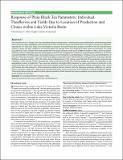| dc.contributor.author | Owuor, P Okinda | |
| dc.contributor.author | Ogola, Peter O | |
| dc.contributor.author | Kamunya, Samson M | |
| dc.date.accessioned | 2020-03-03T19:06:13Z | |
| dc.date.available | 2020-03-03T19:06:13Z | |
| dc.date.issued | 2019 | |
| dc.identifier.citation | Owuor PO, Ogola PO, Kamunya SM. Response of Plain Black Tea Parameters, Individual Theaflavins and Yields Due to Location of Production and Clones within Lake Victoria Basin. International Journal of Tea Science 2019; 14(1):14-25 | en_US |
| dc.identifier.other | DOI: 10.20425/ijts1413 | |
| dc.identifier.uri | https://repository.maseno.ac.ke/handle/123456789/1481 | |
| dc.description.abstract | Tea (Camellia sinensis) is a major cash crop and leading foreign exchange earner, contributing to poverty alleviation by providing employment and livelihood to many stakeholders in the producing countries. Production has increased faster than consumption causing price stagnation, especially for CTC black teas. Kenya is the third-largest tea producer and Lake Victoria Basin produces over 60% of her tea. Selection of tea cultivars in Kenya has been cantered in one location before the selected clones are introduced to other growth environments. This study evaluated if tea clones maintain their yield and plain black tea quality attributes when grown at different locations within Lake Victoria Basin. The basin produces mainly plain black teas whose quality is due to levels of polyphenolic compounds, especially green leaf flavan-3-ols that are oxidized to theaflavins and thearubigins during black tea processing. The theaflavins and thearubigins contribute to the color and brightness of
black teas. The trials were done in two sites Timbilil and Kipkebe using twenty clones. All the plain tea quality parameters including individual
theaflavins and yields varied (p <0.05) with clones, demonstrating diversity in the cultivars used. The levels of the parameters and yields also changed (p <0.05) with the location of production. These results demonstrated that clonal tea quality and yields vary depending on the geographical location of production. There were also significant interactions effects between the clones and location of production in the quality parameters and clones showing the extent of the changes varied from clone to clone. Indeed the relative ranking of the clones varied with location. No clone retained its relative superiority ranking at the two locations. Both the Spearman correlation coefficients (rs) and the Pearson correlation coefficients (r) between the individual parameters were positive but low and insignificant, except for theaflavin-3-gallate. These results demonstrate the need for location-specific evaluation of both new and old clones to establish clonal yield and quality potentials in new locations of cultivation. | en_US |
| dc.description.sponsorship | Inter-University Council of East Africa, Lake Victoria Research Initiative (VicRes) | en_US |
| dc.language.iso | en | en_US |
| dc.publisher | International Society of Tea Science | en_US |
| dc.subject | Tea, Individual theaflavins, quality, yields | en_US |
| dc.title | Response of Plain Black Tea Parameters, Individual Theaflavins and Yields Due to Location of Production and Clones within Lake Victoria Basin | en_US |
| dc.type | Article | en_US |

